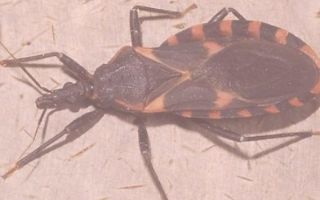Chagas disease (American trypanosomiasis) is a disease caused by trypanosomes and transmitted by the triatomine bug.
Content
Trypanosoma americana
The simplest single-celled animal that parasitizes the blood plasma, lymph, intestinal smooth muscles, myocardium of warm-blooded animals and humans.
Once in the human body, trypanosomes invade the cells of its tissues and multiply intensively within 1.5-2 months, filling the entire cell. They do not reproduce outside the cell.
The carrier of the disease is the triatomine bug.
Triatomine bug
During blood sucking, as the intestines of the infected insect fill, an act of defecation occurs. His feces contain trypanosomes. Since the bite site is very itchy, when scratching, parasites enter the wound and the human mucous membranes. This is how infection occurs. Bedbugs often bite lips, which is why they have another name – the kissing bug. In addition, they often bite a sleeping person at the edge of the eyelid, where the blood vessels are closest.
When bedbugs feed on the blood of an infected person or animal, the parasites in their intestines take on a dangerous form within 6-15 days. From this moment on, bedbugs become infectious and retain the ability to infect humans and vertebrates throughout their entire life - 1-2 years.
American trypanosomiasis (Chagas disease)
Chagas disease is prevalent mainly in Latin America. However, over the past decades, it has been increasingly detected in the United States of America, Canada, many European countries and some Western Pacific countries. This is mainly caused by the movement of people between Latin America and the rest of the world.
In natural foci, reservoirs of the pathogen are armadillos, opossums (they have a high infection index), anteaters, foxes, monkeys and other vertebrates.
In Peru, the reservoir is guinea pigs, which the population keeps at home for food.
In most people, the disease occurs in a chronic form. The acute form is typical for children aged 1 to 10 years.
Infection is also possible through blood transfusions, hereditary transmission (from infected mother to child) and organ donation, although these cases are more rare.
Symptoms
1-1.5 months after infection, the patient develops
- malaise,
- headache,
- muscle pain,
- chills,
- body temperature rises to 38-40ºС.
With a benign course in older children and adults, the temperature may rise slightly.
There is an increase in cervical, axillary, inguinal and other groups of lymph nodes.
In the blood - leukocytosis with monocytosis and increased ESR.
If parasites infect the heart, then observed
- myocarditis with arrhythmia,
- bradycardia,
- tachycardia,
- dullness of tones,
- the borders of the heart are expanded predominantly to the left.
In some cases, meningoencephalitis develops.
The acute stage lasts 4-6 weeks, then the disease passes into a chronic, mild phase. This period can last 7-20 years.
However, trypanosomes continue to wreak havoc on health. And after a long period after infection, the disease can manifest itself through serious problems with the heart or intestines.
If the heart is affected, then its ventricles are dilated, their walls are thinned, changes in the electrocardiogram (ECG) indicate disturbances in the conduction functions and excitability of the myocardium.
Intestinal damage can lead to damage to the smooth muscles of the intestine, especially often the sigmoid muscle and causes swallowing disorders, constipation, megacolon (excessive dilatation of the intestine), and intestinal obstruction.
Damage to the peripheral ganglia of the nervous system is sometimes accompanied by convulsions and paralysis.
In these cases, it is very important to determine the true causes of these ailments.
Diagnostics
When interviewing, the doctor first finds out whether the patient has been in areas where the disease is common.
Confirmation of the disease is based on laboratory blood tests.
Treatment
Treatment is possible only in the acute stage - with benznidazole or nifurtimox. If you consult a doctor early, there is a high probability of complete recovery.
Prognosis and prevention
In severe cases of the disease, especially in children, the prognosis is unfavorable due to the frequent development of meningoencephalitis.
In adults, the prognosis for life is more favorable, but for recovery it is doubtful. The disease limits the patient's social activity and sharply reduces life expectancy.
The main measure to prevent Chagas disease is the destruction of bedbugs. For this purpose, special means have been developed: insecticidal paints for painting the walls of premises and fumigation canisters that maintain a low concentration of insecticidal aerosol in the premises.
Early seeking medical help improves prognosis.
The greatest successes in the fight against this disease have been achieved in Argentina, Bolivia, Brazil, Paraguay, Uruguay and Chile.







